Effect of Culture, Politics & Power on Behaviour in Organisational Behaviour
VerifiedAdded on 2023/01/12
|14
|4030
|90
AI Summary
This document explores the effect of culture, politics, and power on the behavior of individuals and teams in organisational behaviour. It discusses the different types of culture, the impact of power on behavior, and the role of politics in the workplace. The document also covers motivational theories, the importance of soft skills for teams and managers, and the characteristics of effective and ineffective teams. The case study of Costa coffeehouse is used as an example throughout the document.
Contribute Materials
Your contribution can guide someone’s learning journey. Share your
documents today.
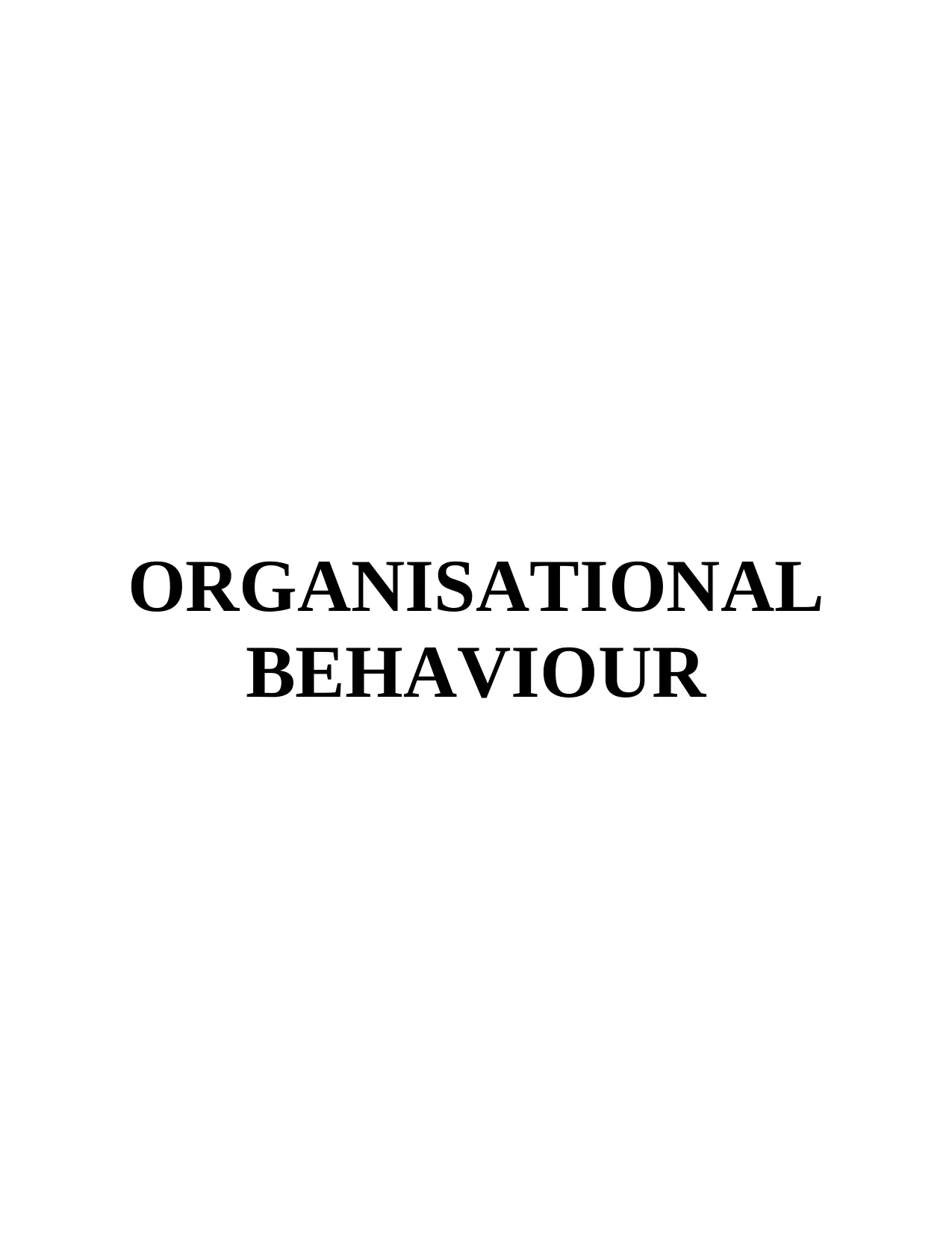
ORGANISATIONAL
BEHAVIOUR
BEHAVIOUR
Secure Best Marks with AI Grader
Need help grading? Try our AI Grader for instant feedback on your assignments.
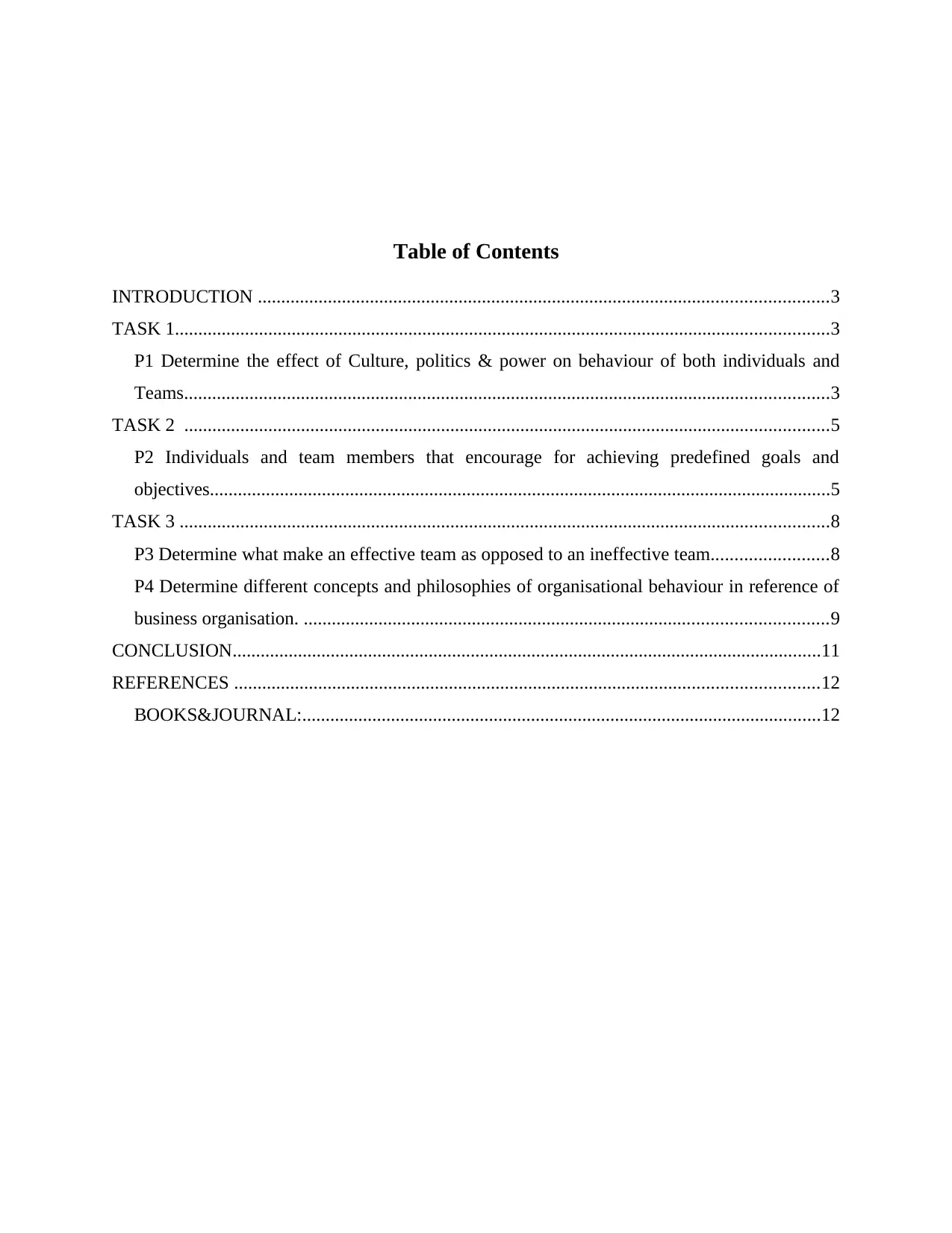
Table of Contents
INTRODUCTION ..........................................................................................................................3
TASK 1............................................................................................................................................3
P1 Determine the effect of Culture, politics & power on behaviour of both individuals and
Teams..........................................................................................................................................3
TASK 2 ..........................................................................................................................................5
P2 Individuals and team members that encourage for achieving predefined goals and
objectives.....................................................................................................................................5
TASK 3 ...........................................................................................................................................8
P3 Determine what make an effective team as opposed to an ineffective team.........................8
P4 Determine different concepts and philosophies of organisational behaviour in reference of
business organisation. ................................................................................................................9
CONCLUSION..............................................................................................................................11
REFERENCES .............................................................................................................................12
BOOKS&JOURNAL:...............................................................................................................12
INTRODUCTION ..........................................................................................................................3
TASK 1............................................................................................................................................3
P1 Determine the effect of Culture, politics & power on behaviour of both individuals and
Teams..........................................................................................................................................3
TASK 2 ..........................................................................................................................................5
P2 Individuals and team members that encourage for achieving predefined goals and
objectives.....................................................................................................................................5
TASK 3 ...........................................................................................................................................8
P3 Determine what make an effective team as opposed to an ineffective team.........................8
P4 Determine different concepts and philosophies of organisational behaviour in reference of
business organisation. ................................................................................................................9
CONCLUSION..............................................................................................................................11
REFERENCES .............................................................................................................................12
BOOKS&JOURNAL:...............................................................................................................12
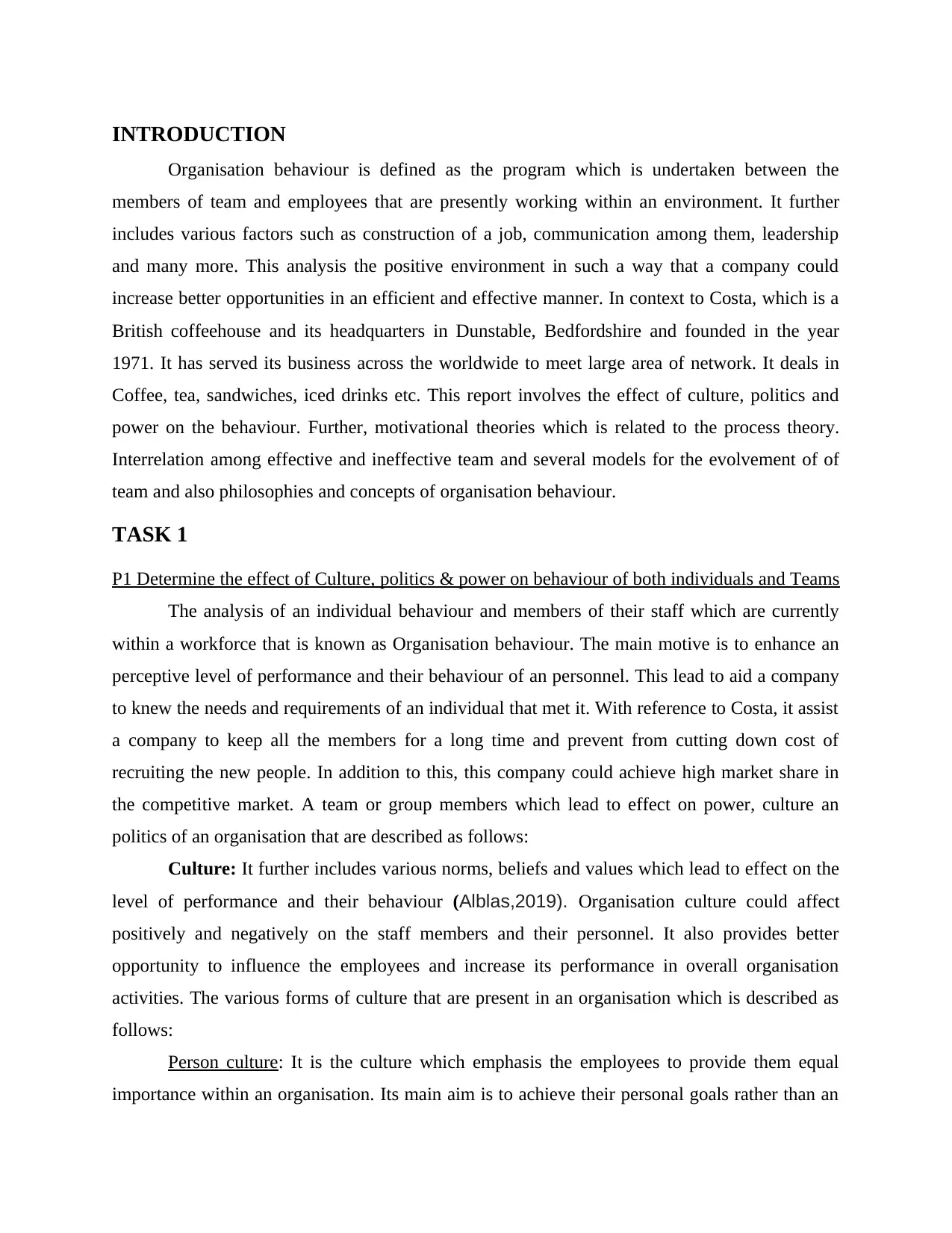
INTRODUCTION
Organisation behaviour is defined as the program which is undertaken between the
members of team and employees that are presently working within an environment. It further
includes various factors such as construction of a job, communication among them, leadership
and many more. This analysis the positive environment in such a way that a company could
increase better opportunities in an efficient and effective manner. In context to Costa, which is a
British coffeehouse and its headquarters in Dunstable, Bedfordshire and founded in the year
1971. It has served its business across the worldwide to meet large area of network. It deals in
Coffee, tea, sandwiches, iced drinks etc. This report involves the effect of culture, politics and
power on the behaviour. Further, motivational theories which is related to the process theory.
Interrelation among effective and ineffective team and several models for the evolvement of of
team and also philosophies and concepts of organisation behaviour.
TASK 1
P1 Determine the effect of Culture, politics & power on behaviour of both individuals and Teams
The analysis of an individual behaviour and members of their staff which are currently
within a workforce that is known as Organisation behaviour. The main motive is to enhance an
perceptive level of performance and their behaviour of an personnel. This lead to aid a company
to knew the needs and requirements of an individual that met it. With reference to Costa, it assist
a company to keep all the members for a long time and prevent from cutting down cost of
recruiting the new people. In addition to this, this company could achieve high market share in
the competitive market. A team or group members which lead to effect on power, culture an
politics of an organisation that are described as follows:
Culture: It further includes various norms, beliefs and values which lead to effect on the
level of performance and their behaviour (Alblas,2019). Organisation culture could affect
positively and negatively on the staff members and their personnel. It also provides better
opportunity to influence the employees and increase its performance in overall organisation
activities. The various forms of culture that are present in an organisation which is described as
follows:
Person culture: It is the culture which emphasis the employees to provide them equal
importance within an organisation. Its main aim is to achieve their personal goals rather than an
Organisation behaviour is defined as the program which is undertaken between the
members of team and employees that are presently working within an environment. It further
includes various factors such as construction of a job, communication among them, leadership
and many more. This analysis the positive environment in such a way that a company could
increase better opportunities in an efficient and effective manner. In context to Costa, which is a
British coffeehouse and its headquarters in Dunstable, Bedfordshire and founded in the year
1971. It has served its business across the worldwide to meet large area of network. It deals in
Coffee, tea, sandwiches, iced drinks etc. This report involves the effect of culture, politics and
power on the behaviour. Further, motivational theories which is related to the process theory.
Interrelation among effective and ineffective team and several models for the evolvement of of
team and also philosophies and concepts of organisation behaviour.
TASK 1
P1 Determine the effect of Culture, politics & power on behaviour of both individuals and Teams
The analysis of an individual behaviour and members of their staff which are currently
within a workforce that is known as Organisation behaviour. The main motive is to enhance an
perceptive level of performance and their behaviour of an personnel. This lead to aid a company
to knew the needs and requirements of an individual that met it. With reference to Costa, it assist
a company to keep all the members for a long time and prevent from cutting down cost of
recruiting the new people. In addition to this, this company could achieve high market share in
the competitive market. A team or group members which lead to effect on power, culture an
politics of an organisation that are described as follows:
Culture: It further includes various norms, beliefs and values which lead to effect on the
level of performance and their behaviour (Alblas,2019). Organisation culture could affect
positively and negatively on the staff members and their personnel. It also provides better
opportunity to influence the employees and increase its performance in overall organisation
activities. The various forms of culture that are present in an organisation which is described as
follows:
Person culture: It is the culture which emphasis the employees to provide them equal
importance within an organisation. Its main aim is to achieve their personal goals rather than an
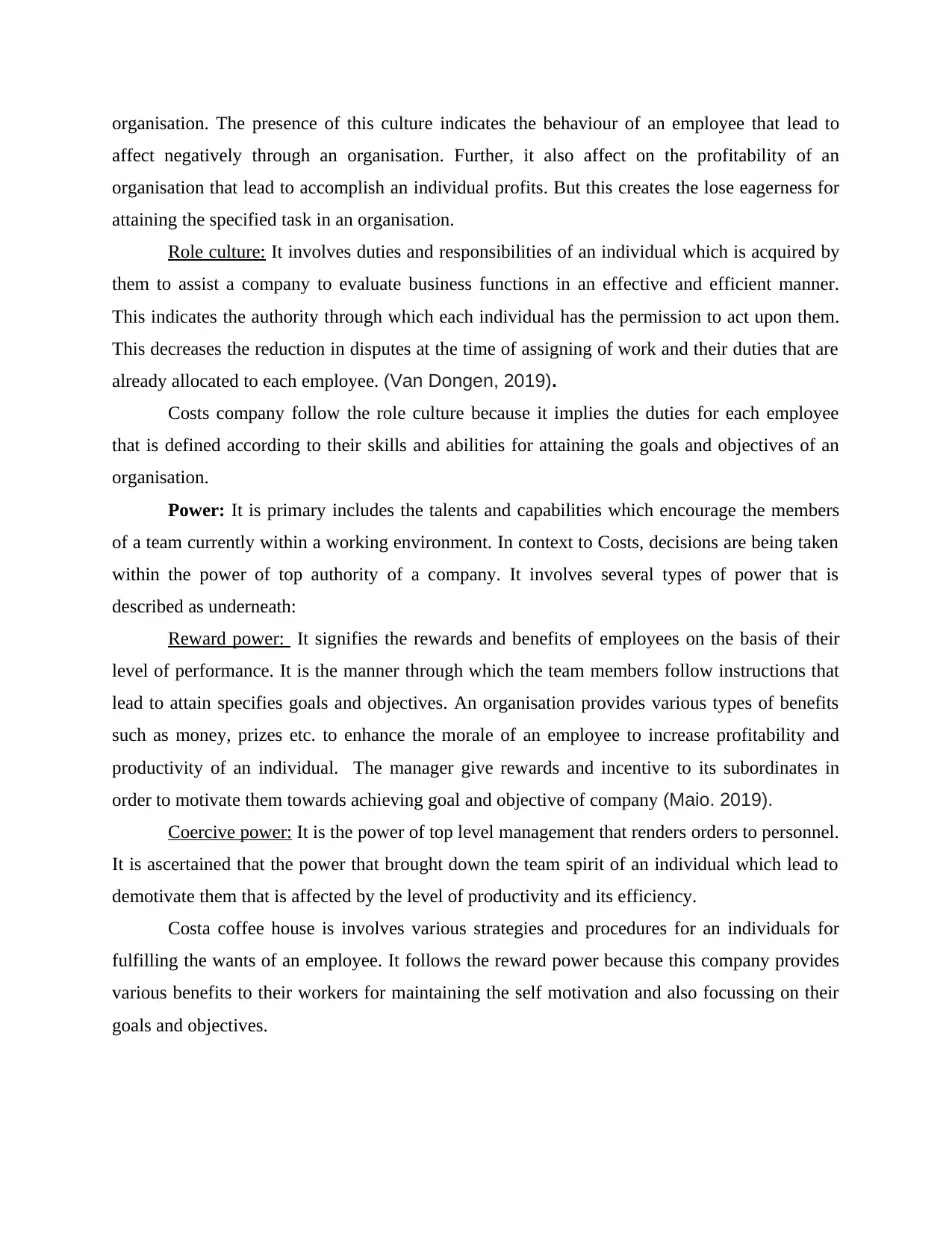
organisation. The presence of this culture indicates the behaviour of an employee that lead to
affect negatively through an organisation. Further, it also affect on the profitability of an
organisation that lead to accomplish an individual profits. But this creates the lose eagerness for
attaining the specified task in an organisation.
Role culture: It involves duties and responsibilities of an individual which is acquired by
them to assist a company to evaluate business functions in an effective and efficient manner.
This indicates the authority through which each individual has the permission to act upon them.
This decreases the reduction in disputes at the time of assigning of work and their duties that are
already allocated to each employee. (Van Dongen, 2019).
Costs company follow the role culture because it implies the duties for each employee
that is defined according to their skills and abilities for attaining the goals and objectives of an
organisation.
Power: It is primary includes the talents and capabilities which encourage the members
of a team currently within a working environment. In context to Costs, decisions are being taken
within the power of top authority of a company. It involves several types of power that is
described as underneath:
Reward power: It signifies the rewards and benefits of employees on the basis of their
level of performance. It is the manner through which the team members follow instructions that
lead to attain specifies goals and objectives. An organisation provides various types of benefits
such as money, prizes etc. to enhance the morale of an employee to increase profitability and
productivity of an individual. The manager give rewards and incentive to its subordinates in
order to motivate them towards achieving goal and objective of company (Maio. 2019).
Coercive power: It is the power of top level management that renders orders to personnel.
It is ascertained that the power that brought down the team spirit of an individual which lead to
demotivate them that is affected by the level of productivity and its efficiency.
Costa coffee house is involves various strategies and procedures for an individuals for
fulfilling the wants of an employee. It follows the reward power because this company provides
various benefits to their workers for maintaining the self motivation and also focussing on their
goals and objectives.
affect negatively through an organisation. Further, it also affect on the profitability of an
organisation that lead to accomplish an individual profits. But this creates the lose eagerness for
attaining the specified task in an organisation.
Role culture: It involves duties and responsibilities of an individual which is acquired by
them to assist a company to evaluate business functions in an effective and efficient manner.
This indicates the authority through which each individual has the permission to act upon them.
This decreases the reduction in disputes at the time of assigning of work and their duties that are
already allocated to each employee. (Van Dongen, 2019).
Costs company follow the role culture because it implies the duties for each employee
that is defined according to their skills and abilities for attaining the goals and objectives of an
organisation.
Power: It is primary includes the talents and capabilities which encourage the members
of a team currently within a working environment. In context to Costs, decisions are being taken
within the power of top authority of a company. It involves several types of power that is
described as underneath:
Reward power: It signifies the rewards and benefits of employees on the basis of their
level of performance. It is the manner through which the team members follow instructions that
lead to attain specifies goals and objectives. An organisation provides various types of benefits
such as money, prizes etc. to enhance the morale of an employee to increase profitability and
productivity of an individual. The manager give rewards and incentive to its subordinates in
order to motivate them towards achieving goal and objective of company (Maio. 2019).
Coercive power: It is the power of top level management that renders orders to personnel.
It is ascertained that the power that brought down the team spirit of an individual which lead to
demotivate them that is affected by the level of productivity and its efficiency.
Costa coffee house is involves various strategies and procedures for an individuals for
fulfilling the wants of an employee. It follows the reward power because this company provides
various benefits to their workers for maintaining the self motivation and also focussing on their
goals and objectives.
Secure Best Marks with AI Grader
Need help grading? Try our AI Grader for instant feedback on your assignments.
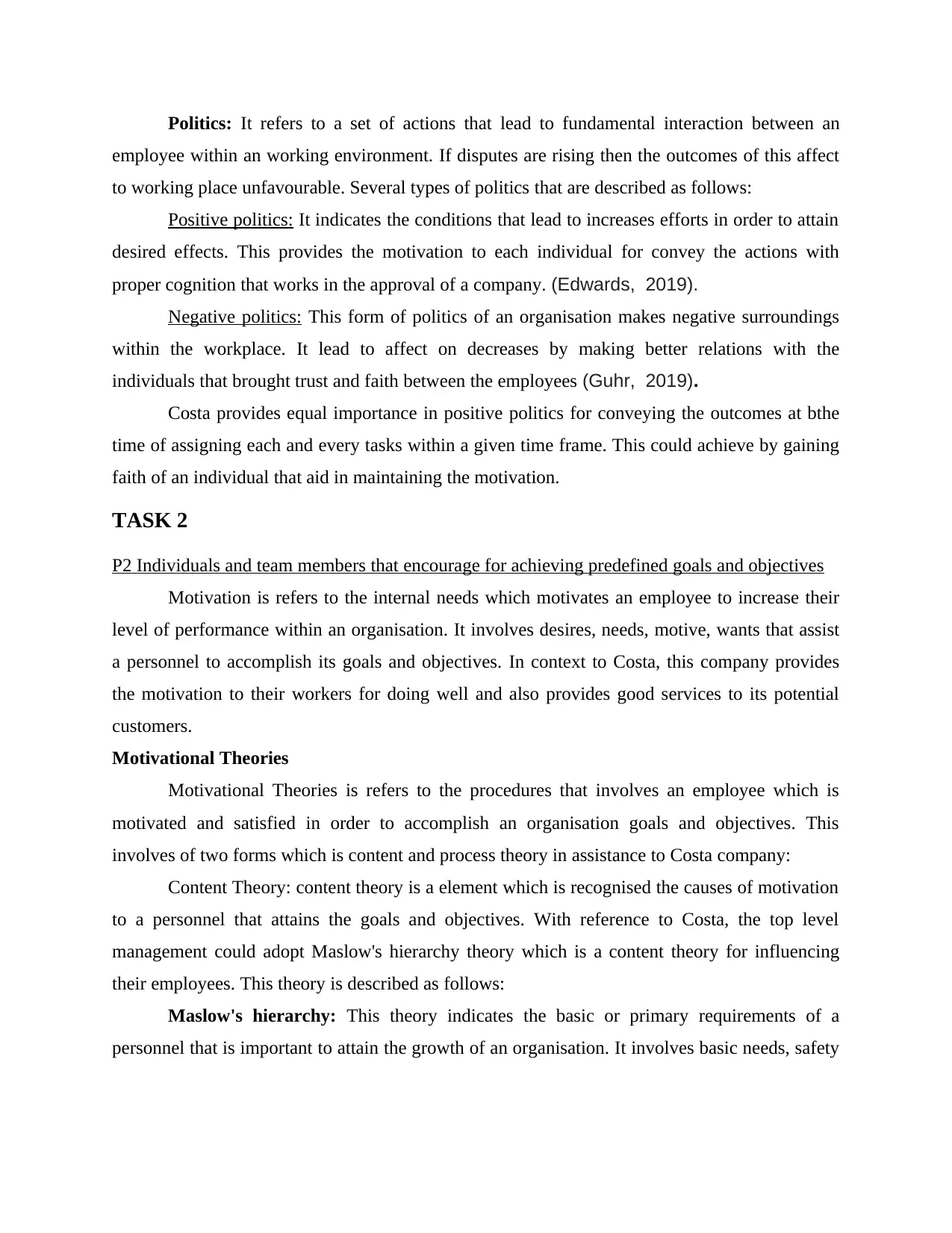
Politics: It refers to a set of actions that lead to fundamental interaction between an
employee within an working environment. If disputes are rising then the outcomes of this affect
to working place unfavourable. Several types of politics that are described as follows:
Positive politics: It indicates the conditions that lead to increases efforts in order to attain
desired effects. This provides the motivation to each individual for convey the actions with
proper cognition that works in the approval of a company. (Edwards, 2019).
Negative politics: This form of politics of an organisation makes negative surroundings
within the workplace. It lead to affect on decreases by making better relations with the
individuals that brought trust and faith between the employees (Guhr, 2019).
Costa provides equal importance in positive politics for conveying the outcomes at bthe
time of assigning each and every tasks within a given time frame. This could achieve by gaining
faith of an individual that aid in maintaining the motivation.
TASK 2
P2 Individuals and team members that encourage for achieving predefined goals and objectives
Motivation is refers to the internal needs which motivates an employee to increase their
level of performance within an organisation. It involves desires, needs, motive, wants that assist
a personnel to accomplish its goals and objectives. In context to Costa, this company provides
the motivation to their workers for doing well and also provides good services to its potential
customers.
Motivational Theories
Motivational Theories is refers to the procedures that involves an employee which is
motivated and satisfied in order to accomplish an organisation goals and objectives. This
involves of two forms which is content and process theory in assistance to Costa company:
Content Theory: content theory is a element which is recognised the causes of motivation
to a personnel that attains the goals and objectives. With reference to Costa, the top level
management could adopt Maslow's hierarchy theory which is a content theory for influencing
their employees. This theory is described as follows:
Maslow's hierarchy: This theory indicates the basic or primary requirements of a
personnel that is important to attain the growth of an organisation. It involves basic needs, safety
employee within an working environment. If disputes are rising then the outcomes of this affect
to working place unfavourable. Several types of politics that are described as follows:
Positive politics: It indicates the conditions that lead to increases efforts in order to attain
desired effects. This provides the motivation to each individual for convey the actions with
proper cognition that works in the approval of a company. (Edwards, 2019).
Negative politics: This form of politics of an organisation makes negative surroundings
within the workplace. It lead to affect on decreases by making better relations with the
individuals that brought trust and faith between the employees (Guhr, 2019).
Costa provides equal importance in positive politics for conveying the outcomes at bthe
time of assigning each and every tasks within a given time frame. This could achieve by gaining
faith of an individual that aid in maintaining the motivation.
TASK 2
P2 Individuals and team members that encourage for achieving predefined goals and objectives
Motivation is refers to the internal needs which motivates an employee to increase their
level of performance within an organisation. It involves desires, needs, motive, wants that assist
a personnel to accomplish its goals and objectives. In context to Costa, this company provides
the motivation to their workers for doing well and also provides good services to its potential
customers.
Motivational Theories
Motivational Theories is refers to the procedures that involves an employee which is
motivated and satisfied in order to accomplish an organisation goals and objectives. This
involves of two forms which is content and process theory in assistance to Costa company:
Content Theory: content theory is a element which is recognised the causes of motivation
to a personnel that attains the goals and objectives. With reference to Costa, the top level
management could adopt Maslow's hierarchy theory which is a content theory for influencing
their employees. This theory is described as follows:
Maslow's hierarchy: This theory indicates the basic or primary requirements of a
personnel that is important to attain the growth of an organisation. It involves basic needs, safety
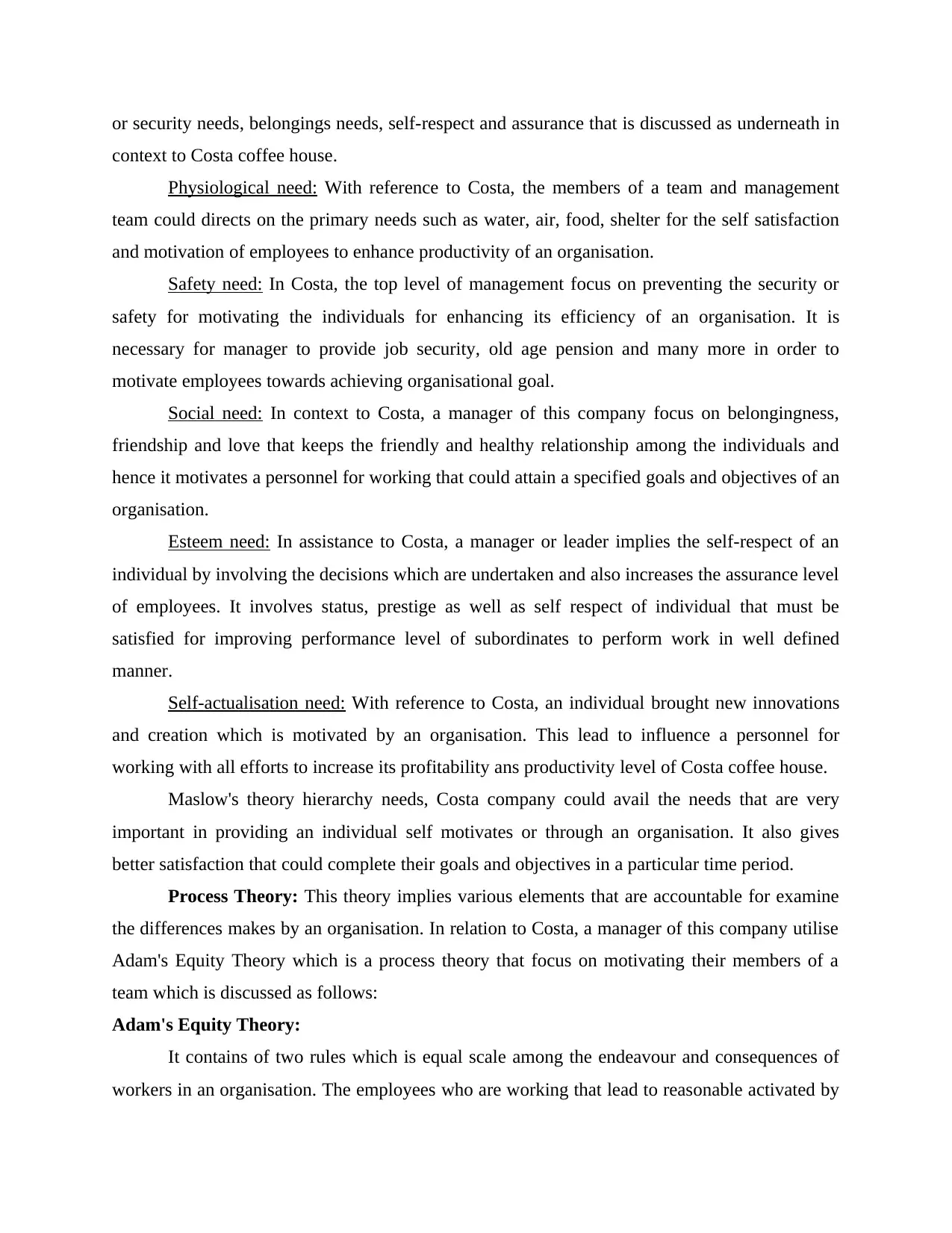
or security needs, belongings needs, self-respect and assurance that is discussed as underneath in
context to Costa coffee house.
Physiological need: With reference to Costa, the members of a team and management
team could directs on the primary needs such as water, air, food, shelter for the self satisfaction
and motivation of employees to enhance productivity of an organisation.
Safety need: In Costa, the top level of management focus on preventing the security or
safety for motivating the individuals for enhancing its efficiency of an organisation. It is
necessary for manager to provide job security, old age pension and many more in order to
motivate employees towards achieving organisational goal.
Social need: In context to Costa, a manager of this company focus on belongingness,
friendship and love that keeps the friendly and healthy relationship among the individuals and
hence it motivates a personnel for working that could attain a specified goals and objectives of an
organisation.
Esteem need: In assistance to Costa, a manager or leader implies the self-respect of an
individual by involving the decisions which are undertaken and also increases the assurance level
of employees. It involves status, prestige as well as self respect of individual that must be
satisfied for improving performance level of subordinates to perform work in well defined
manner.
Self-actualisation need: With reference to Costa, an individual brought new innovations
and creation which is motivated by an organisation. This lead to influence a personnel for
working with all efforts to increase its profitability ans productivity level of Costa coffee house.
Maslow's theory hierarchy needs, Costa company could avail the needs that are very
important in providing an individual self motivates or through an organisation. It also gives
better satisfaction that could complete their goals and objectives in a particular time period.
Process Theory: This theory implies various elements that are accountable for examine
the differences makes by an organisation. In relation to Costa, a manager of this company utilise
Adam's Equity Theory which is a process theory that focus on motivating their members of a
team which is discussed as follows:
Adam's Equity Theory:
It contains of two rules which is equal scale among the endeavour and consequences of
workers in an organisation. The employees who are working that lead to reasonable activated by
context to Costa coffee house.
Physiological need: With reference to Costa, the members of a team and management
team could directs on the primary needs such as water, air, food, shelter for the self satisfaction
and motivation of employees to enhance productivity of an organisation.
Safety need: In Costa, the top level of management focus on preventing the security or
safety for motivating the individuals for enhancing its efficiency of an organisation. It is
necessary for manager to provide job security, old age pension and many more in order to
motivate employees towards achieving organisational goal.
Social need: In context to Costa, a manager of this company focus on belongingness,
friendship and love that keeps the friendly and healthy relationship among the individuals and
hence it motivates a personnel for working that could attain a specified goals and objectives of an
organisation.
Esteem need: In assistance to Costa, a manager or leader implies the self-respect of an
individual by involving the decisions which are undertaken and also increases the assurance level
of employees. It involves status, prestige as well as self respect of individual that must be
satisfied for improving performance level of subordinates to perform work in well defined
manner.
Self-actualisation need: With reference to Costa, an individual brought new innovations
and creation which is motivated by an organisation. This lead to influence a personnel for
working with all efforts to increase its profitability ans productivity level of Costa coffee house.
Maslow's theory hierarchy needs, Costa company could avail the needs that are very
important in providing an individual self motivates or through an organisation. It also gives
better satisfaction that could complete their goals and objectives in a particular time period.
Process Theory: This theory implies various elements that are accountable for examine
the differences makes by an organisation. In relation to Costa, a manager of this company utilise
Adam's Equity Theory which is a process theory that focus on motivating their members of a
team which is discussed as follows:
Adam's Equity Theory:
It contains of two rules which is equal scale among the endeavour and consequences of
workers in an organisation. The employees who are working that lead to reasonable activated by
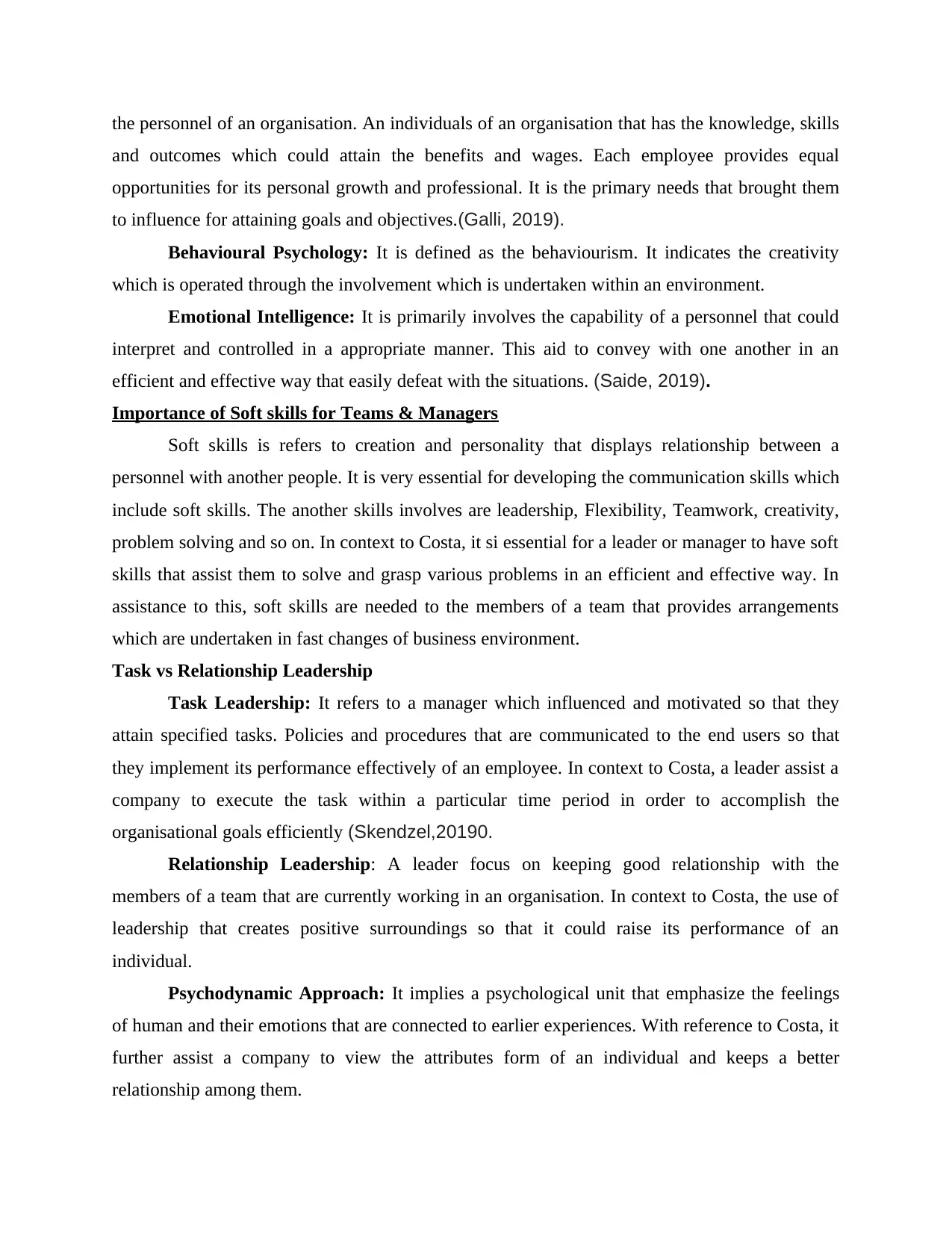
the personnel of an organisation. An individuals of an organisation that has the knowledge, skills
and outcomes which could attain the benefits and wages. Each employee provides equal
opportunities for its personal growth and professional. It is the primary needs that brought them
to influence for attaining goals and objectives.(Galli, 2019).
Behavioural Psychology: It is defined as the behaviourism. It indicates the creativity
which is operated through the involvement which is undertaken within an environment.
Emotional Intelligence: It is primarily involves the capability of a personnel that could
interpret and controlled in a appropriate manner. This aid to convey with one another in an
efficient and effective way that easily defeat with the situations. (Saide, 2019).
Importance of Soft skills for Teams & Managers
Soft skills is refers to creation and personality that displays relationship between a
personnel with another people. It is very essential for developing the communication skills which
include soft skills. The another skills involves are leadership, Flexibility, Teamwork, creativity,
problem solving and so on. In context to Costa, it si essential for a leader or manager to have soft
skills that assist them to solve and grasp various problems in an efficient and effective way. In
assistance to this, soft skills are needed to the members of a team that provides arrangements
which are undertaken in fast changes of business environment.
Task vs Relationship Leadership
Task Leadership: It refers to a manager which influenced and motivated so that they
attain specified tasks. Policies and procedures that are communicated to the end users so that
they implement its performance effectively of an employee. In context to Costa, a leader assist a
company to execute the task within a particular time period in order to accomplish the
organisational goals efficiently (Skendzel,20190.
Relationship Leadership: A leader focus on keeping good relationship with the
members of a team that are currently working in an organisation. In context to Costa, the use of
leadership that creates positive surroundings so that it could raise its performance of an
individual.
Psychodynamic Approach: It implies a psychological unit that emphasize the feelings
of human and their emotions that are connected to earlier experiences. With reference to Costa, it
further assist a company to view the attributes form of an individual and keeps a better
relationship among them.
and outcomes which could attain the benefits and wages. Each employee provides equal
opportunities for its personal growth and professional. It is the primary needs that brought them
to influence for attaining goals and objectives.(Galli, 2019).
Behavioural Psychology: It is defined as the behaviourism. It indicates the creativity
which is operated through the involvement which is undertaken within an environment.
Emotional Intelligence: It is primarily involves the capability of a personnel that could
interpret and controlled in a appropriate manner. This aid to convey with one another in an
efficient and effective way that easily defeat with the situations. (Saide, 2019).
Importance of Soft skills for Teams & Managers
Soft skills is refers to creation and personality that displays relationship between a
personnel with another people. It is very essential for developing the communication skills which
include soft skills. The another skills involves are leadership, Flexibility, Teamwork, creativity,
problem solving and so on. In context to Costa, it si essential for a leader or manager to have soft
skills that assist them to solve and grasp various problems in an efficient and effective way. In
assistance to this, soft skills are needed to the members of a team that provides arrangements
which are undertaken in fast changes of business environment.
Task vs Relationship Leadership
Task Leadership: It refers to a manager which influenced and motivated so that they
attain specified tasks. Policies and procedures that are communicated to the end users so that
they implement its performance effectively of an employee. In context to Costa, a leader assist a
company to execute the task within a particular time period in order to accomplish the
organisational goals efficiently (Skendzel,20190.
Relationship Leadership: A leader focus on keeping good relationship with the
members of a team that are currently working in an organisation. In context to Costa, the use of
leadership that creates positive surroundings so that it could raise its performance of an
individual.
Psychodynamic Approach: It implies a psychological unit that emphasize the feelings
of human and their emotions that are connected to earlier experiences. With reference to Costa, it
further assist a company to view the attributes form of an individual and keeps a better
relationship among them.
Paraphrase This Document
Need a fresh take? Get an instant paraphrase of this document with our AI Paraphraser
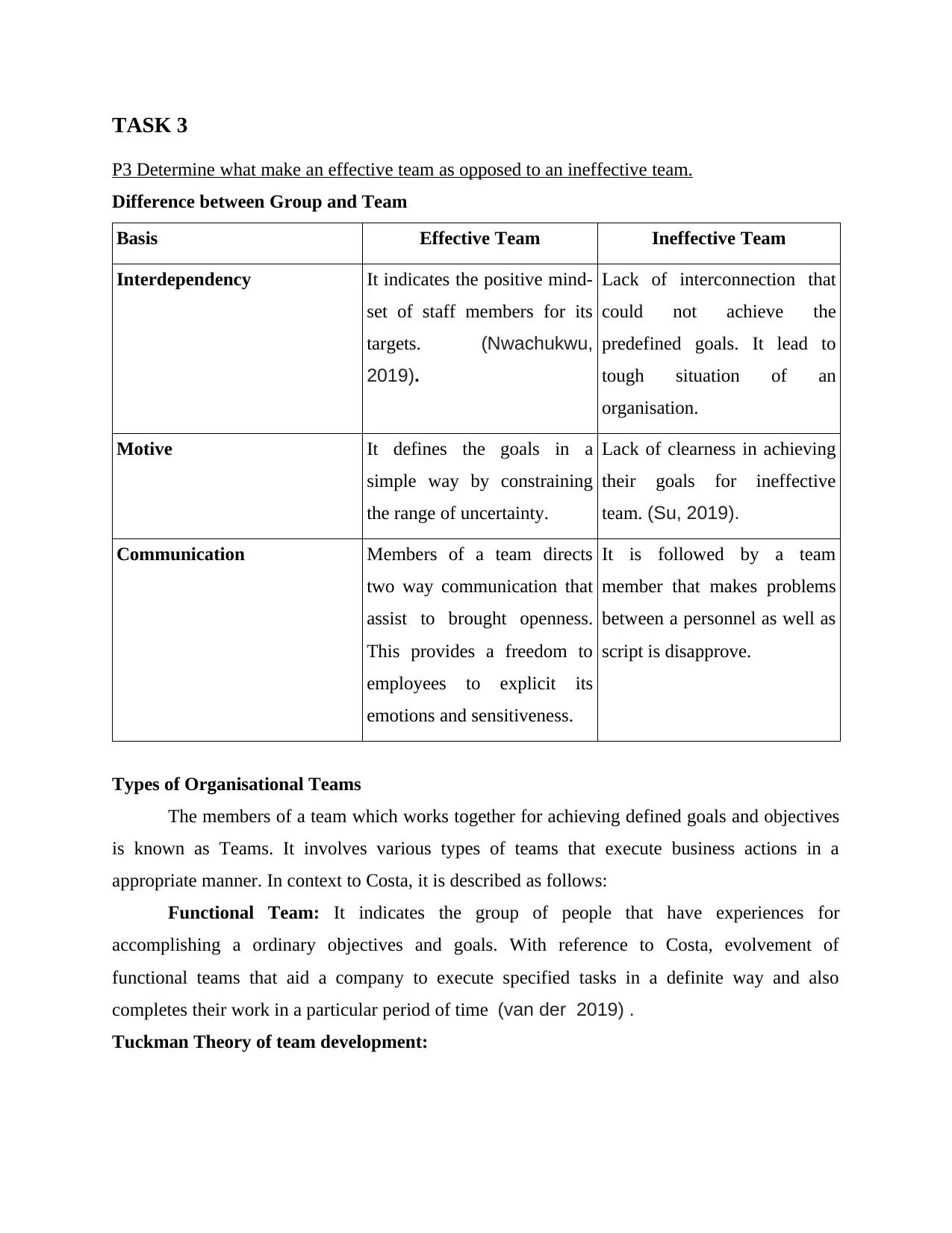
TASK 3
P3 Determine what make an effective team as opposed to an ineffective team.
Difference between Group and Team
Basis Effective Team Ineffective Team
Interdependency It indicates the positive mind-
set of staff members for its
targets. (Nwachukwu,
2019).
Lack of interconnection that
could not achieve the
predefined goals. It lead to
tough situation of an
organisation.
Motive It defines the goals in a
simple way by constraining
the range of uncertainty.
Lack of clearness in achieving
their goals for ineffective
team. (Su, 2019).
Communication Members of a team directs
two way communication that
assist to brought openness.
This provides a freedom to
employees to explicit its
emotions and sensitiveness.
It is followed by a team
member that makes problems
between a personnel as well as
script is disapprove.
Types of Organisational Teams
The members of a team which works together for achieving defined goals and objectives
is known as Teams. It involves various types of teams that execute business actions in a
appropriate manner. In context to Costa, it is described as follows:
Functional Team: It indicates the group of people that have experiences for
accomplishing a ordinary objectives and goals. With reference to Costa, evolvement of
functional teams that aid a company to execute specified tasks in a definite way and also
completes their work in a particular period of time (van der 2019) .
Tuckman Theory of team development:
P3 Determine what make an effective team as opposed to an ineffective team.
Difference between Group and Team
Basis Effective Team Ineffective Team
Interdependency It indicates the positive mind-
set of staff members for its
targets. (Nwachukwu,
2019).
Lack of interconnection that
could not achieve the
predefined goals. It lead to
tough situation of an
organisation.
Motive It defines the goals in a
simple way by constraining
the range of uncertainty.
Lack of clearness in achieving
their goals for ineffective
team. (Su, 2019).
Communication Members of a team directs
two way communication that
assist to brought openness.
This provides a freedom to
employees to explicit its
emotions and sensitiveness.
It is followed by a team
member that makes problems
between a personnel as well as
script is disapprove.
Types of Organisational Teams
The members of a team which works together for achieving defined goals and objectives
is known as Teams. It involves various types of teams that execute business actions in a
appropriate manner. In context to Costa, it is described as follows:
Functional Team: It indicates the group of people that have experiences for
accomplishing a ordinary objectives and goals. With reference to Costa, evolvement of
functional teams that aid a company to execute specified tasks in a definite way and also
completes their work in a particular period of time (van der 2019) .
Tuckman Theory of team development:
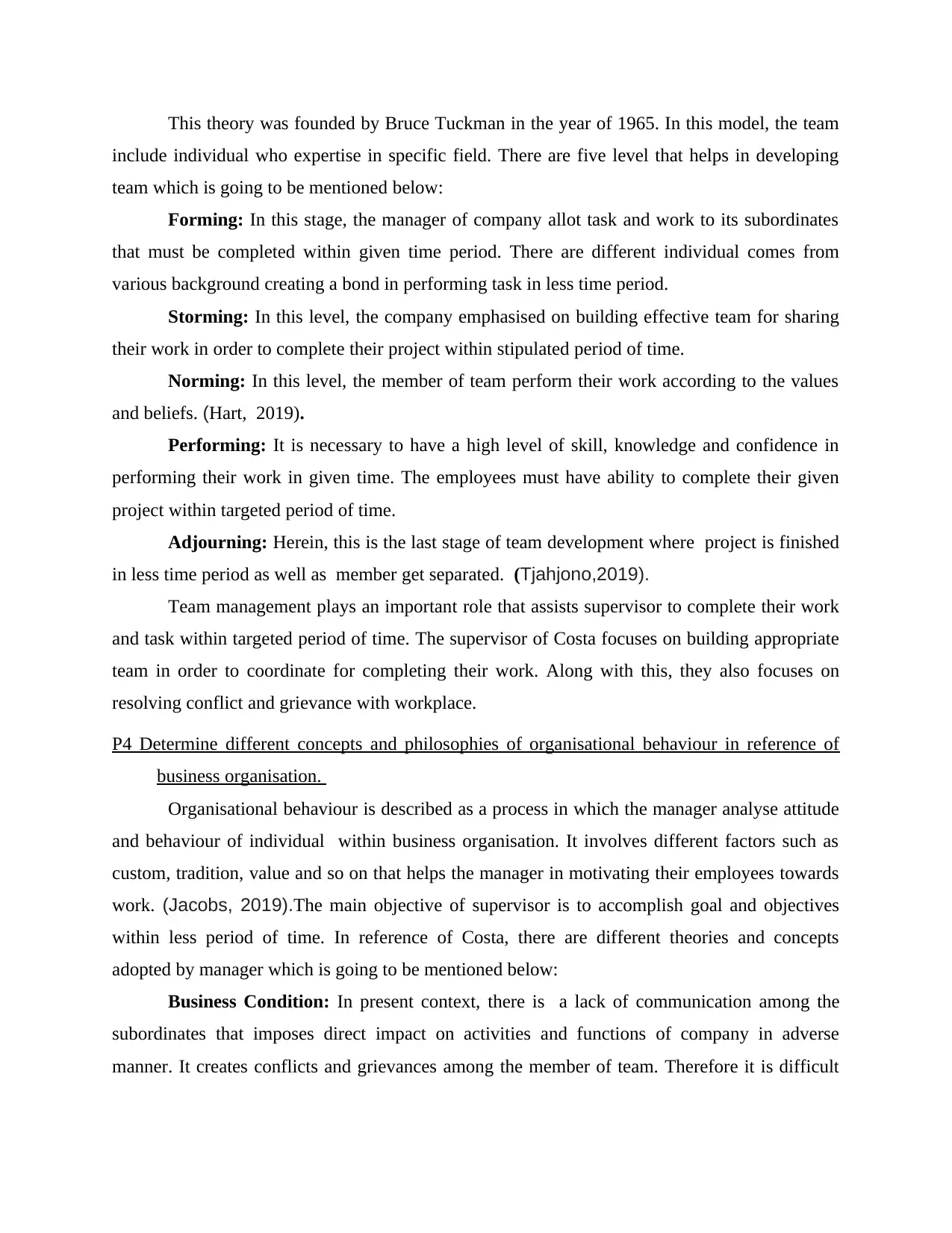
This theory was founded by Bruce Tuckman in the year of 1965. In this model, the team
include individual who expertise in specific field. There are five level that helps in developing
team which is going to be mentioned below:
Forming: In this stage, the manager of company allot task and work to its subordinates
that must be completed within given time period. There are different individual comes from
various background creating a bond in performing task in less time period.
Storming: In this level, the company emphasised on building effective team for sharing
their work in order to complete their project within stipulated period of time.
Norming: In this level, the member of team perform their work according to the values
and beliefs. (Hart, 2019).
Performing: It is necessary to have a high level of skill, knowledge and confidence in
performing their work in given time. The employees must have ability to complete their given
project within targeted period of time.
Adjourning: Herein, this is the last stage of team development where project is finished
in less time period as well as member get separated. (Tjahjono,2019).
Team management plays an important role that assists supervisor to complete their work
and task within targeted period of time. The supervisor of Costa focuses on building appropriate
team in order to coordinate for completing their work. Along with this, they also focuses on
resolving conflict and grievance with workplace.
P4 Determine different concepts and philosophies of organisational behaviour in reference of
business organisation.
Organisational behaviour is described as a process in which the manager analyse attitude
and behaviour of individual within business organisation. It involves different factors such as
custom, tradition, value and so on that helps the manager in motivating their employees towards
work. (Jacobs, 2019).The main objective of supervisor is to accomplish goal and objectives
within less period of time. In reference of Costa, there are different theories and concepts
adopted by manager which is going to be mentioned below:
Business Condition: In present context, there is a lack of communication among the
subordinates that imposes direct impact on activities and functions of company in adverse
manner. It creates conflicts and grievances among the member of team. Therefore it is difficult
include individual who expertise in specific field. There are five level that helps in developing
team which is going to be mentioned below:
Forming: In this stage, the manager of company allot task and work to its subordinates
that must be completed within given time period. There are different individual comes from
various background creating a bond in performing task in less time period.
Storming: In this level, the company emphasised on building effective team for sharing
their work in order to complete their project within stipulated period of time.
Norming: In this level, the member of team perform their work according to the values
and beliefs. (Hart, 2019).
Performing: It is necessary to have a high level of skill, knowledge and confidence in
performing their work in given time. The employees must have ability to complete their given
project within targeted period of time.
Adjourning: Herein, this is the last stage of team development where project is finished
in less time period as well as member get separated. (Tjahjono,2019).
Team management plays an important role that assists supervisor to complete their work
and task within targeted period of time. The supervisor of Costa focuses on building appropriate
team in order to coordinate for completing their work. Along with this, they also focuses on
resolving conflict and grievance with workplace.
P4 Determine different concepts and philosophies of organisational behaviour in reference of
business organisation.
Organisational behaviour is described as a process in which the manager analyse attitude
and behaviour of individual within business organisation. It involves different factors such as
custom, tradition, value and so on that helps the manager in motivating their employees towards
work. (Jacobs, 2019).The main objective of supervisor is to accomplish goal and objectives
within less period of time. In reference of Costa, there are different theories and concepts
adopted by manager which is going to be mentioned below:
Business Condition: In present context, there is a lack of communication among the
subordinates that imposes direct impact on activities and functions of company in adverse
manner. It creates conflicts and grievances among the member of team. Therefore it is difficult
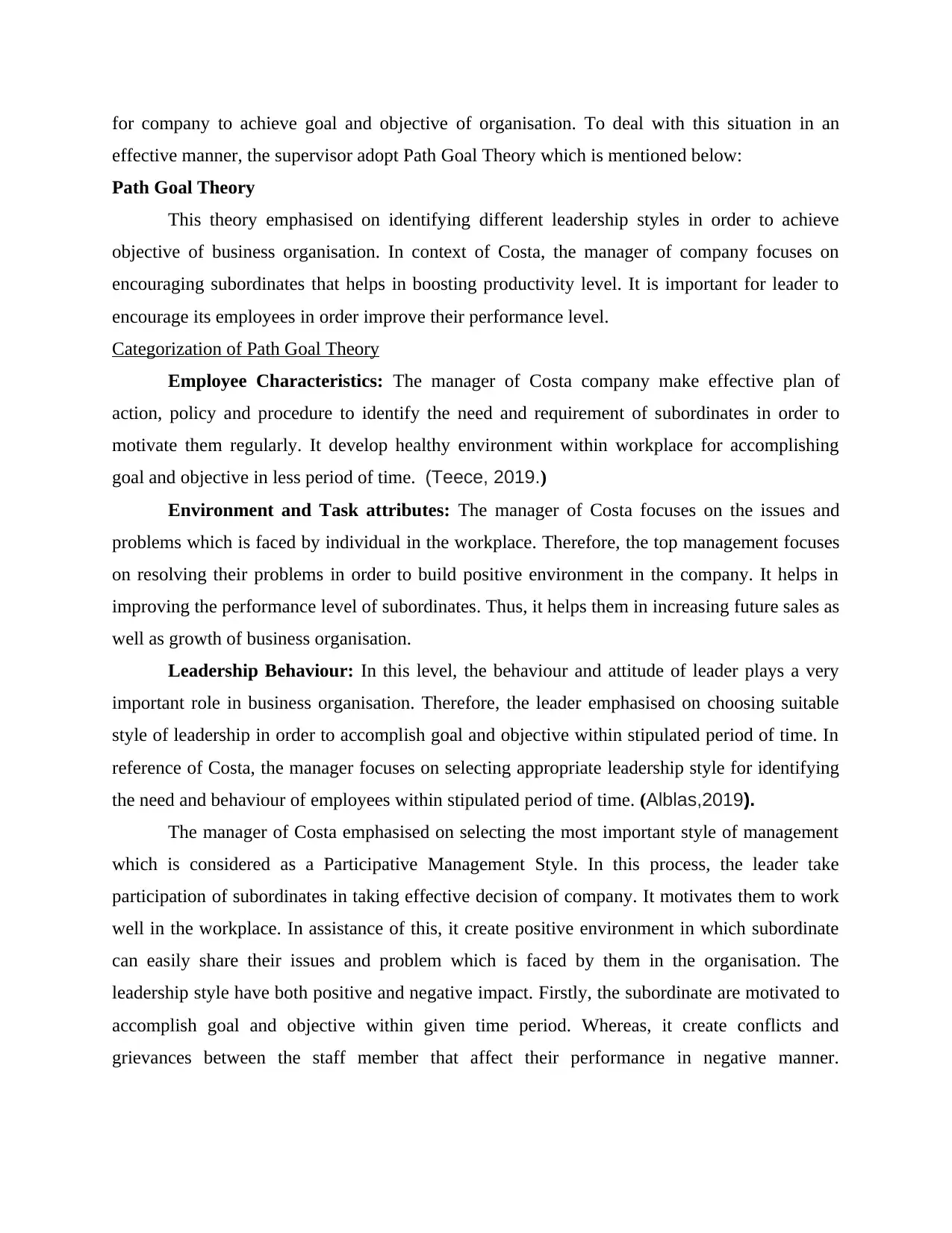
for company to achieve goal and objective of organisation. To deal with this situation in an
effective manner, the supervisor adopt Path Goal Theory which is mentioned below:
Path Goal Theory
This theory emphasised on identifying different leadership styles in order to achieve
objective of business organisation. In context of Costa, the manager of company focuses on
encouraging subordinates that helps in boosting productivity level. It is important for leader to
encourage its employees in order improve their performance level.
Categorization of Path Goal Theory
Employee Characteristics: The manager of Costa company make effective plan of
action, policy and procedure to identify the need and requirement of subordinates in order to
motivate them regularly. It develop healthy environment within workplace for accomplishing
goal and objective in less period of time. (Teece, 2019.)
Environment and Task attributes: The manager of Costa focuses on the issues and
problems which is faced by individual in the workplace. Therefore, the top management focuses
on resolving their problems in order to build positive environment in the company. It helps in
improving the performance level of subordinates. Thus, it helps them in increasing future sales as
well as growth of business organisation.
Leadership Behaviour: In this level, the behaviour and attitude of leader plays a very
important role in business organisation. Therefore, the leader emphasised on choosing suitable
style of leadership in order to accomplish goal and objective within stipulated period of time. In
reference of Costa, the manager focuses on selecting appropriate leadership style for identifying
the need and behaviour of employees within stipulated period of time. (Alblas,2019).
The manager of Costa emphasised on selecting the most important style of management
which is considered as a Participative Management Style. In this process, the leader take
participation of subordinates in taking effective decision of company. It motivates them to work
well in the workplace. In assistance of this, it create positive environment in which subordinate
can easily share their issues and problem which is faced by them in the organisation. The
leadership style have both positive and negative impact. Firstly, the subordinate are motivated to
accomplish goal and objective within given time period. Whereas, it create conflicts and
grievances between the staff member that affect their performance in negative manner.
effective manner, the supervisor adopt Path Goal Theory which is mentioned below:
Path Goal Theory
This theory emphasised on identifying different leadership styles in order to achieve
objective of business organisation. In context of Costa, the manager of company focuses on
encouraging subordinates that helps in boosting productivity level. It is important for leader to
encourage its employees in order improve their performance level.
Categorization of Path Goal Theory
Employee Characteristics: The manager of Costa company make effective plan of
action, policy and procedure to identify the need and requirement of subordinates in order to
motivate them regularly. It develop healthy environment within workplace for accomplishing
goal and objective in less period of time. (Teece, 2019.)
Environment and Task attributes: The manager of Costa focuses on the issues and
problems which is faced by individual in the workplace. Therefore, the top management focuses
on resolving their problems in order to build positive environment in the company. It helps in
improving the performance level of subordinates. Thus, it helps them in increasing future sales as
well as growth of business organisation.
Leadership Behaviour: In this level, the behaviour and attitude of leader plays a very
important role in business organisation. Therefore, the leader emphasised on choosing suitable
style of leadership in order to accomplish goal and objective within stipulated period of time. In
reference of Costa, the manager focuses on selecting appropriate leadership style for identifying
the need and behaviour of employees within stipulated period of time. (Alblas,2019).
The manager of Costa emphasised on selecting the most important style of management
which is considered as a Participative Management Style. In this process, the leader take
participation of subordinates in taking effective decision of company. It motivates them to work
well in the workplace. In assistance of this, it create positive environment in which subordinate
can easily share their issues and problem which is faced by them in the organisation. The
leadership style have both positive and negative impact. Firstly, the subordinate are motivated to
accomplish goal and objective within given time period. Whereas, it create conflicts and
grievances between the staff member that affect their performance in negative manner.
Secure Best Marks with AI Grader
Need help grading? Try our AI Grader for instant feedback on your assignments.
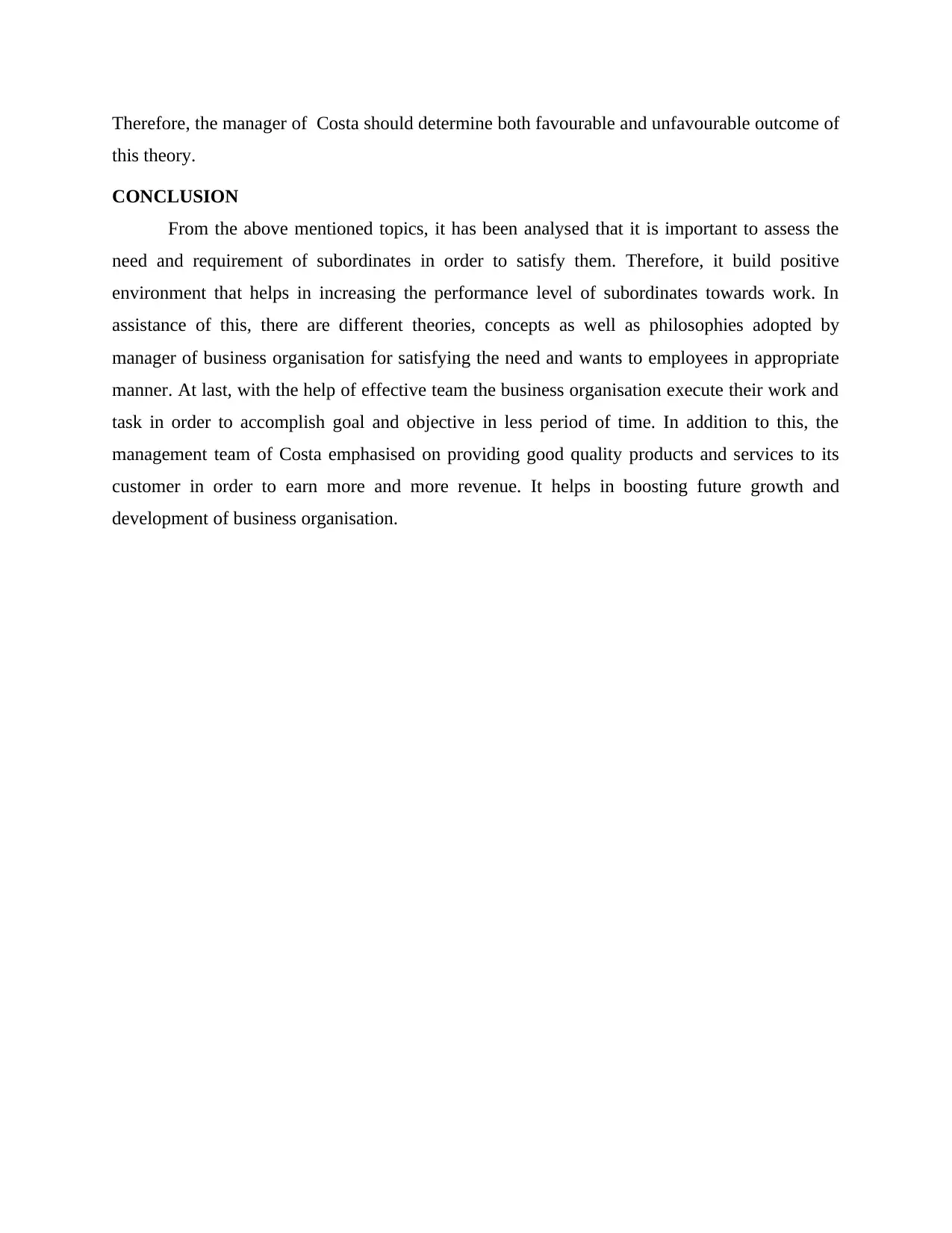
Therefore, the manager of Costa should determine both favourable and unfavourable outcome of
this theory.
CONCLUSION
From the above mentioned topics, it has been analysed that it is important to assess the
need and requirement of subordinates in order to satisfy them. Therefore, it build positive
environment that helps in increasing the performance level of subordinates towards work. In
assistance of this, there are different theories, concepts as well as philosophies adopted by
manager of business organisation for satisfying the need and wants to employees in appropriate
manner. At last, with the help of effective team the business organisation execute their work and
task in order to accomplish goal and objective in less period of time. In addition to this, the
management team of Costa emphasised on providing good quality products and services to its
customer in order to earn more and more revenue. It helps in boosting future growth and
development of business organisation.
this theory.
CONCLUSION
From the above mentioned topics, it has been analysed that it is important to assess the
need and requirement of subordinates in order to satisfy them. Therefore, it build positive
environment that helps in increasing the performance level of subordinates towards work. In
assistance of this, there are different theories, concepts as well as philosophies adopted by
manager of business organisation for satisfying the need and wants to employees in appropriate
manner. At last, with the help of effective team the business organisation execute their work and
task in order to accomplish goal and objective in less period of time. In addition to this, the
management team of Costa emphasised on providing good quality products and services to its
customer in order to earn more and more revenue. It helps in boosting future growth and
development of business organisation.
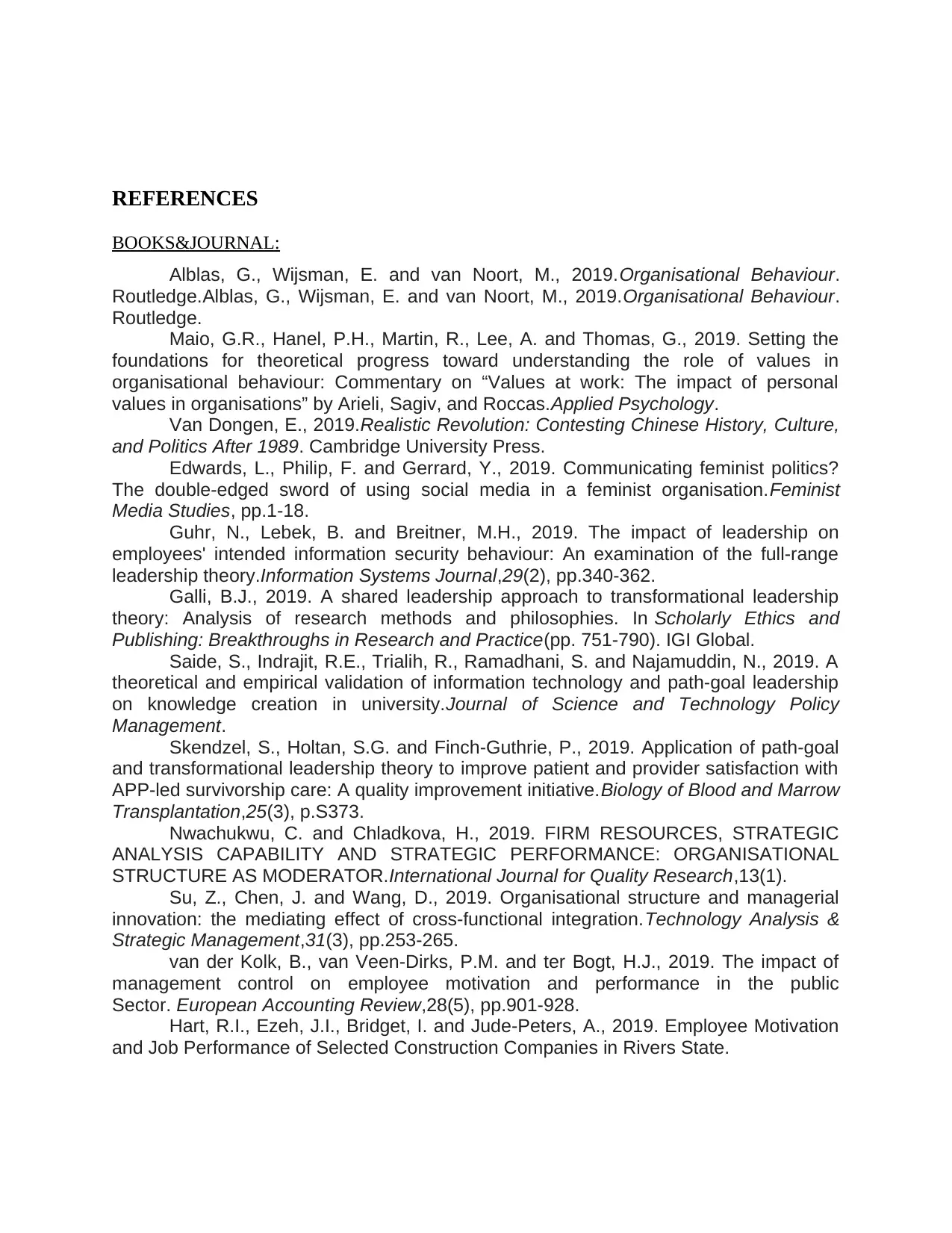
REFERENCES
BOOKS&JOURNAL:
Alblas, G., Wijsman, E. and van Noort, M., 2019.Organisational Behaviour.
Routledge.Alblas, G., Wijsman, E. and van Noort, M., 2019.Organisational Behaviour.
Routledge.
Maio, G.R., Hanel, P.H., Martin, R., Lee, A. and Thomas, G., 2019. Setting the
foundations for theoretical progress toward understanding the role of values in
organisational behaviour: Commentary on “Values at work: The impact of personal
values in organisations” by Arieli, Sagiv, and Roccas.Applied Psychology.
Van Dongen, E., 2019.Realistic Revolution: Contesting Chinese History, Culture,
and Politics After 1989. Cambridge University Press.
Edwards, L., Philip, F. and Gerrard, Y., 2019. Communicating feminist politics?
The double-edged sword of using social media in a feminist organisation.Feminist
Media Studies, pp.1-18.
Guhr, N., Lebek, B. and Breitner, M.H., 2019. The impact of leadership on
employees' intended information security behaviour: An examination of the full‐range
leadership theory.Information Systems Journal,29(2), pp.340-362.
Galli, B.J., 2019. A shared leadership approach to transformational leadership
theory: Analysis of research methods and philosophies. In Scholarly Ethics and
Publishing: Breakthroughs in Research and Practice(pp. 751-790). IGI Global.
Saide, S., Indrajit, R.E., Trialih, R., Ramadhani, S. and Najamuddin, N., 2019. A
theoretical and empirical validation of information technology and path-goal leadership
on knowledge creation in university.Journal of Science and Technology Policy
Management.
Skendzel, S., Holtan, S.G. and Finch-Guthrie, P., 2019. Application of path-goal
and transformational leadership theory to improve patient and provider satisfaction with
APP-led survivorship care: A quality improvement initiative.Biology of Blood and Marrow
Transplantation,25(3), p.S373.
Nwachukwu, C. and Chladkova, H., 2019. FIRM RESOURCES, STRATEGIC
ANALYSIS CAPABILITY AND STRATEGIC PERFORMANCE: ORGANISATIONAL
STRUCTURE AS MODERATOR.International Journal for Quality Research,13(1).
Su, Z., Chen, J. and Wang, D., 2019. Organisational structure and managerial
innovation: the mediating effect of cross-functional integration.Technology Analysis &
Strategic Management,31(3), pp.253-265.
van der Kolk, B., van Veen-Dirks, P.M. and ter Bogt, H.J., 2019. The impact of
management control on employee motivation and performance in the public
Sector. European Accounting Review,28(5), pp.901-928.
Hart, R.I., Ezeh, J.I., Bridget, I. and Jude-Peters, A., 2019. Employee Motivation
and Job Performance of Selected Construction Companies in Rivers State.
BOOKS&JOURNAL:
Alblas, G., Wijsman, E. and van Noort, M., 2019.Organisational Behaviour.
Routledge.Alblas, G., Wijsman, E. and van Noort, M., 2019.Organisational Behaviour.
Routledge.
Maio, G.R., Hanel, P.H., Martin, R., Lee, A. and Thomas, G., 2019. Setting the
foundations for theoretical progress toward understanding the role of values in
organisational behaviour: Commentary on “Values at work: The impact of personal
values in organisations” by Arieli, Sagiv, and Roccas.Applied Psychology.
Van Dongen, E., 2019.Realistic Revolution: Contesting Chinese History, Culture,
and Politics After 1989. Cambridge University Press.
Edwards, L., Philip, F. and Gerrard, Y., 2019. Communicating feminist politics?
The double-edged sword of using social media in a feminist organisation.Feminist
Media Studies, pp.1-18.
Guhr, N., Lebek, B. and Breitner, M.H., 2019. The impact of leadership on
employees' intended information security behaviour: An examination of the full‐range
leadership theory.Information Systems Journal,29(2), pp.340-362.
Galli, B.J., 2019. A shared leadership approach to transformational leadership
theory: Analysis of research methods and philosophies. In Scholarly Ethics and
Publishing: Breakthroughs in Research and Practice(pp. 751-790). IGI Global.
Saide, S., Indrajit, R.E., Trialih, R., Ramadhani, S. and Najamuddin, N., 2019. A
theoretical and empirical validation of information technology and path-goal leadership
on knowledge creation in university.Journal of Science and Technology Policy
Management.
Skendzel, S., Holtan, S.G. and Finch-Guthrie, P., 2019. Application of path-goal
and transformational leadership theory to improve patient and provider satisfaction with
APP-led survivorship care: A quality improvement initiative.Biology of Blood and Marrow
Transplantation,25(3), p.S373.
Nwachukwu, C. and Chladkova, H., 2019. FIRM RESOURCES, STRATEGIC
ANALYSIS CAPABILITY AND STRATEGIC PERFORMANCE: ORGANISATIONAL
STRUCTURE AS MODERATOR.International Journal for Quality Research,13(1).
Su, Z., Chen, J. and Wang, D., 2019. Organisational structure and managerial
innovation: the mediating effect of cross-functional integration.Technology Analysis &
Strategic Management,31(3), pp.253-265.
van der Kolk, B., van Veen-Dirks, P.M. and ter Bogt, H.J., 2019. The impact of
management control on employee motivation and performance in the public
Sector. European Accounting Review,28(5), pp.901-928.
Hart, R.I., Ezeh, J.I., Bridget, I. and Jude-Peters, A., 2019. Employee Motivation
and Job Performance of Selected Construction Companies in Rivers State.
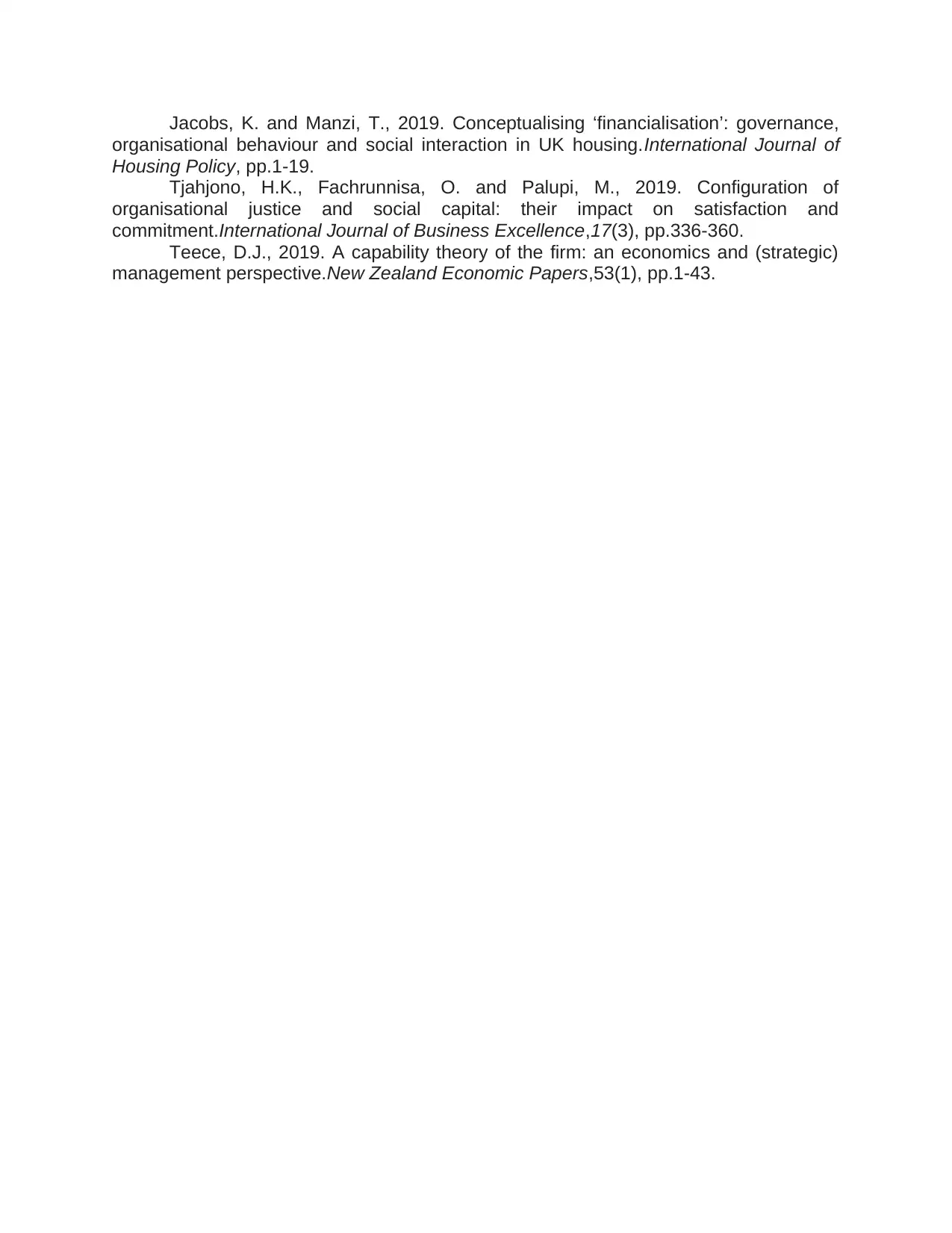
Jacobs, K. and Manzi, T., 2019. Conceptualising ‘financialisation’: governance,
organisational behaviour and social interaction in UK housing.International Journal of
Housing Policy, pp.1-19.
Tjahjono, H.K., Fachrunnisa, O. and Palupi, M., 2019. Configuration of
organisational justice and social capital: their impact on satisfaction and
commitment.International Journal of Business Excellence,17(3), pp.336-360.
Teece, D.J., 2019. A capability theory of the firm: an economics and (strategic)
management perspective.New Zealand Economic Papers,53(1), pp.1-43.
organisational behaviour and social interaction in UK housing.International Journal of
Housing Policy, pp.1-19.
Tjahjono, H.K., Fachrunnisa, O. and Palupi, M., 2019. Configuration of
organisational justice and social capital: their impact on satisfaction and
commitment.International Journal of Business Excellence,17(3), pp.336-360.
Teece, D.J., 2019. A capability theory of the firm: an economics and (strategic)
management perspective.New Zealand Economic Papers,53(1), pp.1-43.
Paraphrase This Document
Need a fresh take? Get an instant paraphrase of this document with our AI Paraphraser

14
1 out of 14
Related Documents
Your All-in-One AI-Powered Toolkit for Academic Success.
+13062052269
info@desklib.com
Available 24*7 on WhatsApp / Email
![[object Object]](/_next/static/media/star-bottom.7253800d.svg)
Unlock your academic potential
© 2024 | Zucol Services PVT LTD | All rights reserved.




